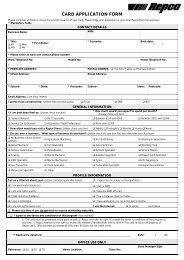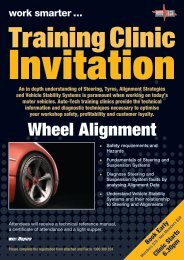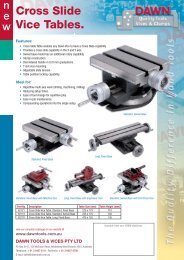45005_Repco_08 Radiator Application Guide Master - Repco Trade ...
45005_Repco_08 Radiator Application Guide Master - Repco Trade ...
45005_Repco_08 Radiator Application Guide Master - Repco Trade ...
Create successful ePaper yourself
Turn your PDF publications into a flip-book with our unique Google optimized e-Paper software.
<strong>Radiator</strong> Installation Procedure<br />
WARNING<br />
FAILURE TO INSTALL THIS RADIATOR ASSEMBLY WITHOUT STRICTLY ADHERING TO THE FOLLOWING PROCEDURES WILL VOID THE<br />
RADIATOR MANUFACTURERS' WARRANTY.<br />
A WARRANTY CLAIM WILL NOT BE ACCEPTED WITHOUT PRODUCING A FULLY COMPLETED AND SIGNED, INSTALLATION<br />
CERTIFICATE, ACCOMPANIED BY A COPY OF THE VEHICLE OWNERS' PURCHASE INVOICE.<br />
Part A - Installing a New <strong>Radiator</strong> (Replacing Old, Faulty, Or Damaged <strong>Radiator</strong> Existing In Vehicle)<br />
1. Prior to removing the existing radiator, the cooling system must be inspected for evidence of stray / electric current.<br />
(This is only possible when the cooling system is still operational)<br />
Stray/electric current causes a highly destructive form of corrosion (electrolysis).<br />
This is caused by the passage of even the smallest (.05 volt) current through the coolant in the system. The resulting fast acting corrosion attacks not only<br />
the radiator and heater cores, but can also cause severe and expensive damage to alloy cylinder heads, water pumps and other component parts, including<br />
the auto transmission.<br />
This condition occurs within the cooling system mainly due to current seeking an easy path through the coolant in search of ground. Typically, this is a<br />
result of accident damage to the vehicle, poor installation of electrical components, and faults occurring in electrical components.<br />
Use an analogue voltmeter (with a sensitivity of .05 volts), or a stray current detector to check for the presence of electrical current by placing the positive<br />
lead directly into the coolant, (filler neck on the radiator) or in the overflow bottle (closed system), making sure the terminal is not in contact with any<br />
surrounding metal surfaces.<br />
Attach the negative lead to the battery earth (negative terminal). Switch on all of the vehicles' electrical systems, one at a time, first with the engine running,<br />
and then repeat the process with the engine off. A reading of more than .05 volts or a ‘positive’ (red light) indicates a damaging current is likely to be<br />
present in the cooling system.<br />
This procedure will enable you to establish, by process of elimination, the source of the current. It is imperative that the source of any current traveling<br />
through the coolant is located, and repaired or replaced, prior to installing a new radiator assembly.<br />
90
















